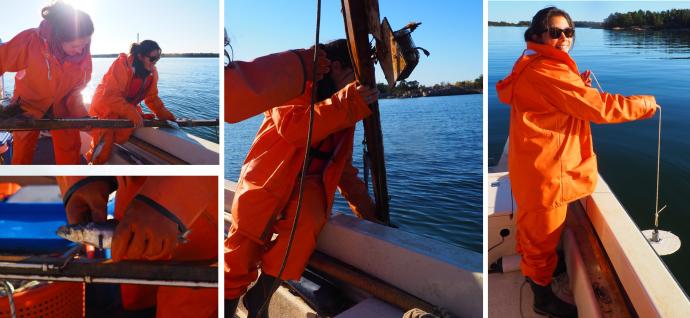Testing the "dinner-bell" effect in the Baltic Sea

The first part of this study was carried out in the bay of Bråviken, in the archipelago of Östergötland, Sweden (Fig. 1). This study was conducted during 4 months in total, from August 2nd until November 29th, 2017.

A station consisted of a 2-meter-long wooden pole fixed to the sea bottom by a 20 kg anchor via a rope and marked with a surface flag buoy (Fig. 2 and 3). The buoys were small in size and had the exact same appearance in order to give as little visual cues to the seals as possible. The anchor was attached to a counterweight through a pulley, which kept the anchor rope tight and facilitated regular servicing of the stations (Fig. 2). Mounted on the wooden pole were: a pinger (either Aquamark100, Aquatec 2446 pinger or a Banana pinger, or no pinger as a control treatment), a waterproof case containing a smartphone (Motorola 5G), two to three fish, a pool thermometer, and an underwater camera (Mobius ActionCam) with long-lasting battery pack (camera set-ups were present only in five of the twenty stations). If fish had been taken from a station, that particular station was moved 200-300 m from the previous location. This measure avoided potential biases from seals learning the location of each buoy.
Servicing of stations involved removal of old fish (if not taken), collection of data from the smartphone, collection of environmental parameters; followed by attachment of fresh, thawed fish, a charged smartphone, change of pinger, and relocation of the station if the fish were taken. A click detector (ECD1, NewLeap Ltd., UK) was used to test that all the pingers were working properly before deployment and after retrieval.
The twenty stations were serviced 572 times in total in the present study. Throughout the 4 months this study took place, 1123 fish were deployed in total across the different treatments (1025 herring, 29 perch, 29 flounder, 26 whitefish, and 14 salmon). Control stations were deployed with a total of 450 fish; Aquamark stations with 329 fish; Aquatec with stations 128 fish and Banana stations with 216 fish.

Responsible for this page:
Director of undergraduate studies Biology
Last updated:
06/06/18
